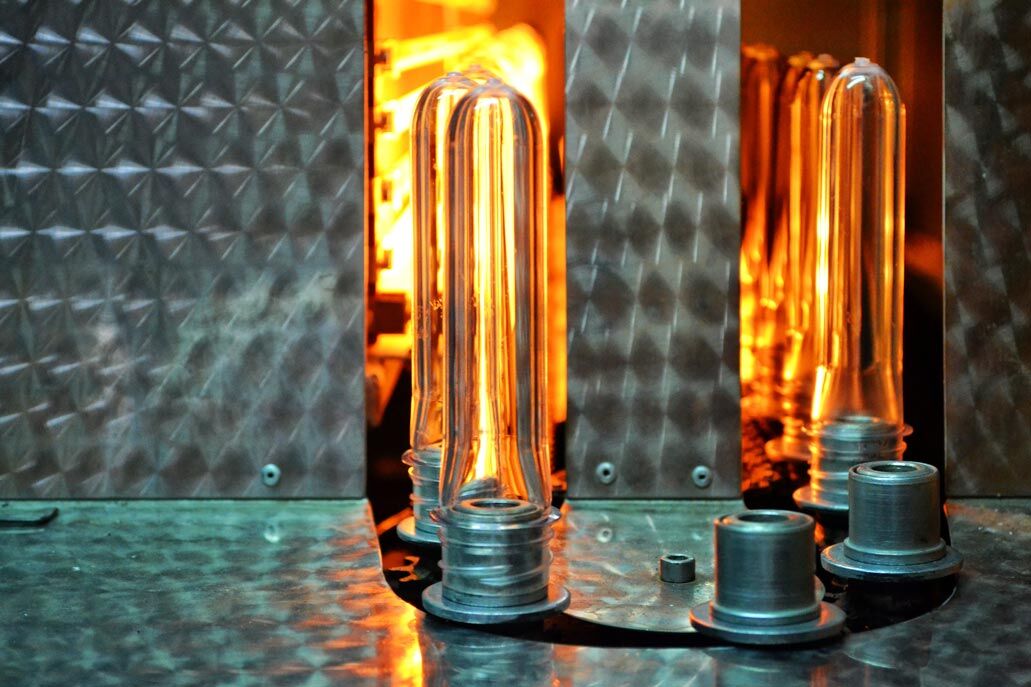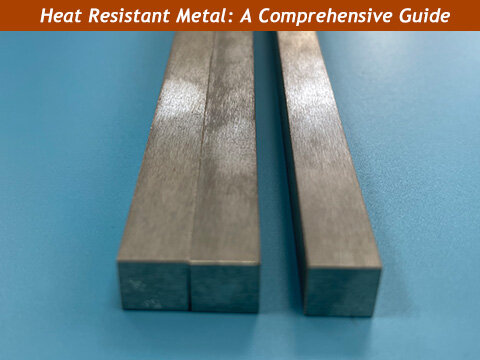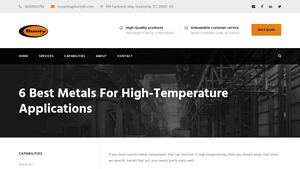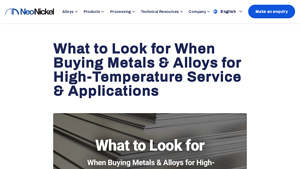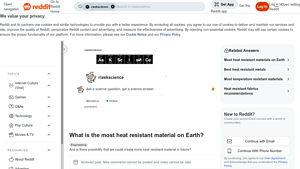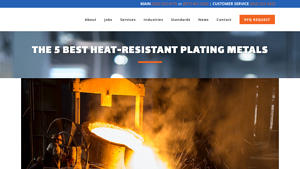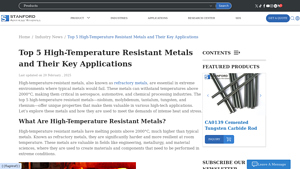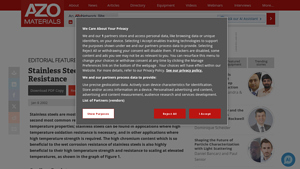Heat Resistant Metal Guide: Type, Cost, Top List…
Introduction: Navigating the Global Market for heat resistant metal
In an increasingly competitive global marketplace, sourcing heat-resistant metals presents a unique challenge for B2B buyers, particularly those in regions like Africa, South America, the Middle East, and Europe, including countries such as Vietnam and Germany. The need for materials that can withstand extreme temperatures while maintaining structural integrity is paramount across various industries, from aerospace to automotive and energy production. This guide delves deep into the realm of heat-resistant metals, offering an extensive overview of the most effective alloys available, their specific applications, and the critical properties that define their performance.
Throughout this guide, readers will find detailed analyses of essential heat-resistant metals, including titanium, tungsten, stainless steel, and more. Each section will outline their composition, mechanical properties, and suitability for various high-temperature applications, ensuring that buyers are well-equipped to make informed decisions. Additionally, we will cover vital considerations for supplier vetting, cost factors, and procurement strategies tailored to the unique needs of international markets. By empowering B2B buyers with actionable insights and comprehensive knowledge, this guide aims to streamline the sourcing process and enhance the overall purchasing experience for businesses navigating the complexities of heat-resistant metal procurement.
Understanding heat resistant metal Types and Variations
| Type Name | Key Distinguishing Features | Primary B2B Applications | Brief Pros & Cons for Buyers |
|---|---|---|---|
| Titanium | High strength-to-weight ratio, excellent corrosion resistance, lightweight | Aerospace, automotive, medical equipment | Pros: Lightweight, strong, versatile. Cons: Higher cost, requires specialized processing. |
| Tungsten | Highest melting point of all metals, exceptional hardness, low thermal expansion | Aerospace components, cutting tools, electronics | Pros: Extremely durable, high-temperature performance. Cons: Difficult to machine, heavy. |
| Stainless Steel | Corrosion resistance, recyclable, can withstand high temperatures | Construction, automotive, food processing | Pros: Versatile, eco-friendly, good mechanical properties. Cons: Can be more expensive than carbon steel. |
| Molybdenum | High melting point, enhances strength and durability, good resistance to wear | Specialty machinery, military applications | Pros: Excellent high-temperature strength. Cons: Limited availability, can be costly. |
| Nickel | Superior oxidation resistance, malleable, enhances strength in alloys | Chemical processing, aerospace, electronics | Pros: Excellent corrosion resistance, improves alloy performance. Cons: Price volatility, can be less effective alone. |
What Are the Key Characteristics of Titanium and Its Applications?
Titanium is renowned for its impressive strength-to-weight ratio and outstanding corrosion resistance. With a melting point of 1,668 °C (3,034 °F), it is suitable for high-temperature applications across various industries. B2B buyers should consider titanium for aerospace components, medical devices, and automotive parts, where lightweight yet durable materials are critical. However, its higher cost and need for specialized processing can be a consideration for budget-conscious buyers.
How Does Tungsten Stand Out in High-Temperature Applications?
Tungsten is the metal with the highest melting point (3,422 °C or 6,192 °F) and is exceptionally hard, making it ideal for demanding applications. It is commonly used in aerospace components, cutting tools, and various electronic applications. For B2B purchasers, tungsten offers unparalleled durability and temperature resistance. However, its difficulty in machining and heavier weight compared to other metals may pose challenges in certain applications.
Why is Stainless Steel a Popular Choice Among B2B Buyers?
Stainless steel is a versatile alloy known for its corrosion resistance and ability to withstand high temperatures. Composed primarily of iron, chromium, and nickel, it is widely used in construction, automotive, and food processing industries. B2B buyers appreciate stainless steel for its eco-friendliness and recyclability, although it can be more expensive than traditional carbon steel. Its mechanical properties make it a reliable choice for various applications.
What Advantages Does Molybdenum Offer for Specialty Applications?
Molybdenum is distinguished by its high melting point and exceptional strength at elevated temperatures. It is often used in specialty machinery and military applications where durability and resistance to wear are essential. B2B buyers should consider molybdenum for projects requiring robust materials, though they must be aware of its limited availability and potential cost implications.
How Does Nickel Enhance the Performance of Alloys?
Nickel is valued for its superior resistance to oxidation and ability to enhance the strength of various alloys. It is commonly used in the chemical processing, aerospace, and electronics sectors. B2B buyers looking for materials that can withstand harsh environments should consider nickel alloys. However, they should also take into account the price volatility of nickel and its limited effectiveness when used alone.
Key Industrial Applications of heat resistant metal
| Industry/Sector | Specific Application of Heat Resistant Metal | Value/Benefit for the Business | Key Sourcing Considerations for this Application |
|---|---|---|---|
| Aerospace | Engine components and turbine blades | Enhanced performance and safety in extreme conditions | Certification compliance, high-temperature resistance, and weight considerations |
| Automotive | Exhaust systems and turbochargers | Improved durability and efficiency under high stress | Material standards, heat resistance ratings, and cost-effectiveness |
| Oil & Gas | Drilling equipment and valves | Reliability and longevity in harsh environments | Corrosion resistance, maintenance requirements, and sourcing from certified suppliers |
| Power Generation | Boiler tubes and heat exchangers | Increased efficiency and reduced downtime | Thermal conductivity, pressure ratings, and compatibility with existing systems |
| Medical Equipment | Surgical instruments and implants | Biocompatibility and strength for critical applications | Regulatory compliance, sterilization capabilities, and material traceability |
How is Heat Resistant Metal Utilized in the Aerospace Sector?
In the aerospace industry, heat resistant metals are critical for manufacturing engine components and turbine blades. These components must endure extreme temperatures and stresses during flight. Using titanium and nickel-based alloys ensures that parts maintain structural integrity and performance under these conditions. International B2B buyers must prioritize materials that meet stringent certification standards and possess high-temperature resistance to ensure safety and reliability in aircraft operations.
What Role Does Heat Resistant Metal Play in Automotive Applications?
Heat resistant metals are essential in automotive applications, particularly for exhaust systems and turbochargers, where they must withstand high temperatures and corrosive environments. The use of stainless steel and titanium alloys enhances durability and efficiency, leading to better vehicle performance. Buyers should consider material standards and heat resistance ratings to ensure the longevity of these components while also balancing cost-effectiveness in sourcing.
Why is Heat Resistant Metal Important in the Oil & Gas Industry?
In the oil and gas sector, heat resistant metals are used in drilling equipment and valves, which face harsh environmental conditions. These metals provide reliability and longevity, minimizing the risk of equipment failure. Buyers in this industry should focus on corrosion-resistant materials and maintenance requirements, ensuring that sourced products can withstand the demanding conditions typical of oil and gas operations.
How Does Heat Resistant Metal Enhance Power Generation Systems?
Heat resistant metals are vital in power generation, particularly in boiler tubes and heat exchangers. These components require materials that can handle high temperatures and pressures while maintaining efficiency. Sourcing considerations should include thermal conductivity and compatibility with existing systems, as these factors significantly impact operational performance and energy efficiency.
What Are the Applications of Heat Resistant Metal in Medical Equipment?
In the medical field, heat resistant metals are used to manufacture surgical instruments and implants that demand high strength and biocompatibility. Materials like titanium are favored for their corrosion resistance and durability, critical for patient safety. Buyers should ensure compliance with regulatory standards and verify sterilization capabilities, as these factors are essential for maintaining the integrity of medical devices.
3 Common User Pain Points for ‘heat resistant metal’ & Their Solutions
Scenario 1: Ensuring Consistent Performance in High-Temperature Applications
The Problem: B2B buyers in sectors like aerospace, automotive, and energy production often face the challenge of selecting heat-resistant metals that can endure extreme temperatures without compromising structural integrity. Many buyers find themselves overwhelmed by the variety of alloys available, struggling to determine which materials will maintain their performance over long operational periods. This confusion can lead to costly production downtimes, failures, and safety risks if the chosen metal cannot withstand the thermal stress of its application.
The Solution: To effectively source heat-resistant metals, buyers should conduct a thorough analysis of their specific operational environments. This includes understanding the temperature ranges and exposure durations their components will face. Engage with suppliers who can provide detailed material performance data, including oxidation resistance, tensile strength, and creep resistance. Utilize tools like heat maps or simulation software to predict how different alloys will perform in your specific application. Additionally, consider collaborating with material scientists or metallurgists who can assist in selecting the right alloy, such as titanium or tungsten, based on the specific thermal and mechanical demands of your project.
Scenario 2: Balancing Cost with Quality in Heat-Resistant Metals
The Problem: Cost sensitivity is a significant concern for B2B buyers, especially in emerging markets where budgets are tight. Buyers often face the dilemma of needing high-quality, heat-resistant metals that can perform reliably at high temperatures while also staying within budget constraints. This challenge is compounded by the risk of compromising on quality when opting for cheaper alternatives, which can lead to product failures and increased long-term costs.
The Solution: To achieve a balance between cost and quality, buyers should adopt a strategic sourcing approach. Start by identifying multiple suppliers that offer heat-resistant metals and request samples for testing. This allows you to evaluate the performance of different alloys without committing to large orders. Look for suppliers who offer comprehensive technical support, as they can provide insights into the lifecycle costs of the materials and potential savings from reduced maintenance and downtime. Additionally, consider investing in alloys that have superior heat resistance properties, such as molybdenum or niobium, which may have a higher upfront cost but can ultimately reduce operational costs due to their durability and longevity.
Scenario 3: Navigating the Complexities of Alloy Specifications
The Problem: Many B2B buyers struggle with understanding the technical specifications of heat-resistant metals, leading to miscommunication with suppliers and potential mismatches in material selection. This issue is particularly prevalent in industries like construction and manufacturing, where precise material specifications are critical for safety and compliance. Inaccurate specifications can result in delays, increased costs, and even legal liabilities.
The Solution: To navigate the complexities of alloy specifications, buyers should invest time in educating themselves about the properties and applications of different heat-resistant metals. Consider attending industry seminars or workshops focused on material science and engineering. When communicating with suppliers, be clear about your application requirements, including temperature ranges, exposure conditions, and mechanical stress factors. Utilize standardized terminology and reference industry specifications (such as ASTM or ISO standards) to ensure clarity. Additionally, develop a checklist that outlines critical specifications for your projects, which can serve as a guide during discussions with suppliers to mitigate the risk of misunderstandings. Engaging in regular training for procurement teams can also enhance their understanding of material properties and improve overall sourcing effectiveness.
Strategic Material Selection Guide for heat resistant metal
What Are the Key Properties of Titanium as a Heat Resistant Metal?
Titanium is a prominent choice for heat-resistant applications due to its impressive strength-to-weight ratio and high melting point of 1,668 °C (3,034 °F). It exhibits excellent corrosion resistance, making it suitable for harsh environments, including marine and chemical applications. Additionally, titanium alloys can withstand significant mechanical stress and have a low thermal expansion coefficient, which is crucial in applications where dimensional stability is essential.
Pros and Cons of Titanium in B2B Applications
The advantages of titanium include its lightweight nature, high tensile strength, and resistance to oxidation. However, it is relatively expensive compared to other metals, which can impact overall project costs. Manufacturing processes for titanium can also be complex, requiring specialized equipment and techniques, which may lead to longer lead times. Its applications are diverse, ranging from aerospace components to medical devices, making it a versatile option for various industries.
How Does Tungsten Compare as a Heat Resistant Metal?
Tungsten stands out as one of the toughest metals, with the highest melting point of any element at 3,422 °C (6,192 °F). Its exceptional hardness and tensile strength make it ideal for high-stress applications. Tungsten is often used in environments that require durability, such as aerospace and military applications, as well as in cutting tools and electrical contacts.
Pros and Cons of Tungsten in B2B Applications
While tungsten offers remarkable heat resistance and strength, it is also very dense and difficult to machine, which can complicate manufacturing processes. Its high cost can be a barrier for some projects, particularly in cost-sensitive markets. However, its unique properties make it indispensable in applications where performance cannot be compromised.
What Are the Advantages of Stainless Steel for Heat Resistance?
Stainless steel, particularly high-performance grades, is widely used in high-temperature applications due to its excellent corrosion resistance and ability to maintain strength at elevated temperatures. With a melting point around 1,400 °C (2,552 °F), it is suitable for various industrial applications, including pressure vessels, boilers, and heat exchangers.
Pros and Cons of Stainless Steel in B2B Applications
The main advantages of stainless steel include its recyclability and lower cost compared to titanium and tungsten. However, it may not perform as well in extreme temperatures compared to these metals. The manufacturing processes for stainless steel are well-established, making it easier to source and produce. Its widespread use across industries ensures compatibility with international standards, which is beneficial for global buyers.
What Specific Considerations Should International Buyers Keep in Mind?
When selecting heat-resistant metals, international B2B buyers, especially from regions like Africa, South America, the Middle East, and Europe, must consider compliance with local and international standards such as ASTM, DIN, and JIS. Understanding the specific requirements of their applications, including temperature ratings and corrosion resistance, is crucial. Additionally, factors such as supply chain logistics, material availability, and cost fluctuations can significantly impact procurement decisions.
| Material | Typical Use Case for heat resistant metal | Key Advantage | Key Disadvantage/Limitation | Relative Cost (Low/Med/High) |
|---|---|---|---|---|
| Titanium | Aerospace components, medical devices | Lightweight with high strength | High cost and complex manufacturing | High |
| Tungsten | Cutting tools, aerospace, military | Highest melting point and hardness | Difficult to machine and expensive | High |
| Stainless Steel | Pressure vessels, heat exchangers | Corrosion resistance and recyclability | Lower performance at extreme temperatures | Medium |
In-depth Look: Manufacturing Processes and Quality Assurance for heat resistant metal
What Are the Key Stages in the Manufacturing Process of Heat Resistant Metals?
The manufacturing of heat resistant metals involves a series of critical stages designed to ensure that the final product meets rigorous performance standards. These stages typically include material preparation, forming, assembly, and finishing.
-
Material Preparation
This initial stage is crucial, as it determines the properties of the heat resistant metal. Raw materials, often in the form of ingots or powders, are selected based on their thermal properties and alloying elements. Processes such as melting, alloying, and casting are employed to produce the desired base material. For example, titanium may be produced using the Kroll process, while tungsten often requires powder metallurgy techniques due to its high melting point and hardness. -
Forming
Once the materials are prepared, they undergo forming processes, which can include forging, rolling, and extrusion. These methods shape the metal into semi-finished products. For instance, titanium alloys are often forged to enhance their mechanical properties, while stainless steel may be rolled into sheets or coils for various applications. The choice of forming technique is influenced by the intended use of the final product and the specific heat resistance requirements. -
Assembly
In cases where multiple components are required, assembly becomes necessary. This stage may involve welding, machining, or fastening different parts together. Heat resistant metals, like nickel alloys and stainless steel, are particularly suited for welding due to their high-temperature performance and mechanical strength. Precision is essential during this phase to ensure that the assembled product can withstand the intended thermal and mechanical stresses. -
Finishing
The final stage of manufacturing involves finishing processes such as heat treatment, surface treatment, and coating. Heat treatment can enhance the mechanical properties of alloys, while surface treatments can improve corrosion resistance. For example, molybdenum components may undergo oxidation treatments to bolster their performance in high-temperature environments. Proper finishing ensures that the heat resistant metals meet specific industry standards and customer requirements.
What Quality Assurance Measures Are Essential for Heat Resistant Metals?
Quality assurance (QA) is paramount in the production of heat resistant metals, as these materials often operate in extreme environments where failure can lead to catastrophic results. Implementing robust QA processes ensures that products meet international and industry-specific standards.
-
What International Standards Should B2B Buyers Consider?
B2B buyers should be familiar with relevant international standards, such as ISO 9001, which focuses on quality management systems. Additional certifications like CE (Conformité Européenne) for products sold in the European market and API (American Petroleum Institute) standards for oil and gas applications are also critical. These standards provide frameworks for maintaining quality throughout the manufacturing process. -
What Are the Key Quality Control Checkpoints?
Quality control (QC) typically involves several checkpoints throughout the manufacturing process:
- Incoming Quality Control (IQC): This initial inspection ensures that raw materials meet specified standards before production begins. It often involves verifying material specifications and conducting preliminary tests.
- In-Process Quality Control (IPQC): During manufacturing, regular inspections are conducted to monitor processes and ensure compliance with quality standards. This may include dimensional checks and mechanical property evaluations.
- Final Quality Control (FQC): After manufacturing, the final products undergo comprehensive testing to verify that they meet performance specifications. This may include stress tests, thermal cycling tests, and chemical composition analysis.
- What Common Testing Methods Are Used?
Various testing methods are employed to ensure the quality and performance of heat resistant metals. Common techniques include:
- Tensile Testing: Measures the strength and ductility of materials under tension.
- Hardness Testing: Assesses the material’s resistance to deformation.
- Thermal Conductivity Testing: Evaluates how well the material can dissipate heat.
- Oxidation Resistance Testing: Determines how the material performs in high-temperature oxidizing environments.
How Can B2B Buyers Verify Supplier Quality Control Processes?
For international B2B buyers, particularly from regions like Africa, South America, the Middle East, and Europe, verifying a supplier’s quality control processes is essential to ensure product reliability.
-
What Are the Best Practices for Conducting Supplier Audits?
Conducting supplier audits can provide insights into a manufacturer’s quality assurance practices. Buyers should look for documented evidence of adherence to international standards, such as audit reports and compliance certifications. Additionally, onsite audits can assess the facilities, equipment, and processes used in production. -
How Important Are Third-Party Inspections?
Engaging third-party inspection agencies can further enhance trust in the supplier’s quality assurance processes. These agencies provide impartial assessments and can verify compliance with industry standards. This is particularly crucial for buyers in sectors like aerospace and automotive, where product failure can have serious consequences. -
What QC/CERT Nuances Should International Buyers Be Aware Of?
International buyers should be aware that quality assurance certifications may vary by region. For example, European standards may differ from those in the U.S. or Asia. It’s important for buyers to communicate their specific requirements clearly and ensure that suppliers are capable of meeting those standards. Additionally, understanding local regulations and certifications can help buyers navigate the complexities of international trade.
Conclusion
Understanding the manufacturing processes and quality assurance measures for heat resistant metals is crucial for B2B buyers looking to procure reliable materials for high-temperature applications. By focusing on the stages of manufacturing, international standards, quality checkpoints, and effective verification methods, buyers can make informed decisions that minimize risks and enhance operational efficiency. Whether sourcing materials for aerospace, automotive, or industrial applications, ensuring quality at every step is essential for successful outcomes.
Practical Sourcing Guide: A Step-by-Step Checklist for ‘heat resistant metal’
To successfully procure heat-resistant metal, B2B buyers must navigate a complex landscape of material specifications, supplier capabilities, and market conditions. This guide provides a structured checklist to streamline your sourcing process, ensuring that you make informed decisions tailored to your specific requirements.
Step 1: Define Your Technical Specifications
Clearly outline the technical requirements for your heat-resistant metal. This includes understanding the operating temperature range, mechanical properties like tensile strength, and corrosion resistance. Specifics such as the required alloy composition (e.g., titanium, tungsten, stainless steel) should be included to ensure you select the right material for your application.
Step 2: Research Market Availability
Investigate the current market landscape for heat-resistant metals. Look for trends in pricing, availability, and the types of alloys that are commonly used in your industry. Understanding the supply chain dynamics will help you anticipate potential challenges and identify reliable suppliers that can meet your needs.
Step 3: Evaluate Potential Suppliers
Before committing, it’s crucial to vet suppliers thoroughly. Request company profiles, case studies, and references from buyers in a similar industry or region. Look for suppliers with experience in providing heat-resistant metals and evaluate their production capabilities, quality assurance processes, and delivery timelines.
- Key Considerations:
- Review certifications (ISO, ASTM) that ensure compliance with industry standards.
- Assess their ability to provide custom alloys if needed.
Step 4: Request Material Samples
Once you have identified potential suppliers, request samples of the heat-resistant metals. Testing samples will allow you to evaluate their performance under conditions similar to your operational environment. Pay attention to characteristics such as weldability, ductility, and resistance to thermal fatigue.
Step 5: Analyze Cost Structures
Cost is a crucial factor in sourcing heat-resistant metals. Analyze the pricing structures of your shortlisted suppliers and consider the total cost of ownership, including shipping, tariffs, and potential wastage during manufacturing. It may be beneficial to obtain quotes for different quantities to understand volume pricing.
- Tip:
- Don’t automatically choose the lowest bid; consider the balance between cost and quality.
Step 6: Confirm Lead Times and Delivery Schedules
Ensure that the suppliers can meet your required lead times and delivery schedules. Delays in the supply chain can significantly impact your production timelines. Confirm the suppliers’ capacity to meet your demands and their track record for timely deliveries.
Step 7: Establish Terms and Conditions
Before finalizing your purchase, establish clear terms and conditions with your supplier. This should include payment terms, warranty details, and conditions for returns or exchanges. A well-defined agreement will protect your interests and minimize risks associated with the procurement process.
By following these steps, B2B buyers can effectively navigate the complexities of sourcing heat-resistant metals, ensuring that they select the right materials for their applications while fostering strong supplier relationships.
Comprehensive Cost and Pricing Analysis for heat resistant metal Sourcing
What Are the Key Cost Components in Heat Resistant Metal Sourcing?
When sourcing heat resistant metals, understanding the cost structure is essential for effective budget management. The primary cost components include:
-
Materials: The type of metal significantly influences costs. For instance, titanium and tungsten tend to be pricier due to their scarcity and specialized applications. Raw material prices fluctuate based on market demand and geopolitical factors, impacting overall costs.
-
Labor: Skilled labor is necessary for the production and fabrication of heat resistant metals. Regions with a high availability of skilled workers may offer cost advantages. However, labor costs can vary widely based on local wage standards and labor laws.
-
Manufacturing Overhead: This encompasses costs related to facilities, equipment, and utilities. Companies with advanced manufacturing technologies may achieve efficiencies that lower overhead costs, while traditional methods may lead to higher expenses.
-
Tooling: Custom tooling for specific metal components can be a significant upfront investment. The complexity of the design and the materials used for tooling will directly affect costs.
-
Quality Control (QC): Rigorous quality assurance processes are critical for ensuring the reliability of heat resistant metals. Costs related to QC include testing, inspections, and certifications, which are especially important for industries like aerospace and medical where safety is paramount.
-
Logistics: Transportation and storage costs can add to the total expenditure. Factors such as distance from suppliers, shipping methods, and customs duties play a crucial role in logistics costs.
-
Margin: Suppliers typically include a profit margin in their pricing, which can vary based on competition and market conditions.
How Do Price Influencers Impact Heat Resistant Metal Sourcing?
Several factors can influence the pricing of heat resistant metals, particularly for international B2B buyers:
-
Volume/MOQ (Minimum Order Quantity): Purchasing in larger quantities often leads to discounts. Suppliers may have different pricing tiers based on volume, incentivizing bulk orders.
-
Specifications and Customization: Custom specifications can significantly affect pricing. The more complex the requirements, the higher the costs due to additional labor and tooling.
-
Materials: The choice of alloy or specific metal will impact the base price. For example, high-performance alloys with enhanced heat resistance properties typically command higher prices.
-
Quality and Certifications: Compliance with international standards (such as ISO or ASTM) may require additional testing and certification, increasing costs. Buyers should verify that suppliers can provide the necessary documentation.
-
Supplier Factors: The reputation and location of suppliers can affect pricing. Established suppliers with a proven track record may charge a premium, but they often provide better reliability and service.
-
Incoterms: Understanding Incoterms is vital for international transactions. Terms such as FOB (Free on Board) or CIF (Cost, Insurance, and Freight) can influence the total landed cost of materials.
What Are the Best Practices for Negotiating Heat Resistant Metal Prices?
B2B buyers should adopt a strategic approach to negotiations:
-
Conduct Market Research: Understanding current market prices and trends will empower buyers during negotiations. Knowledge of material costs and supplier capabilities can provide leverage.
-
Emphasize Total Cost of Ownership: Rather than focusing solely on the purchase price, consider the long-term implications of sourcing decisions, including maintenance, operational costs, and lifespan of the materials.
-
Build Relationships with Suppliers: Establishing strong relationships can lead to better pricing and terms. Suppliers may be more willing to negotiate with buyers who demonstrate loyalty and a history of timely payments.
-
Be Prepared for Pricing Nuances: International buyers must be aware of currency fluctuations, import duties, and local regulations, which can affect pricing. Understanding these factors can prevent unexpected costs.
Disclaimer on Indicative Prices
Prices for heat resistant metals can vary significantly based on market conditions and specific project requirements. Buyers should seek updated quotes from suppliers and conduct thorough due diligence to ensure they are getting the best value for their investments.
Alternatives Analysis: Comparing heat resistant metal With Other Solutions
Understanding Alternatives to Heat Resistant Metal
In high-temperature applications, heat resistant metals are often the go-to solution due to their unique properties. However, there are several viable alternatives that can also meet the demands of extreme thermal environments. This section explores these alternatives, comparing their performance, cost, ease of implementation, maintenance requirements, and best use cases.
Comparison Table
| Comparison Aspect | Heat Resistant Metal | Ceramic Materials | High-Temperature Polymers |
|---|---|---|---|
| Performance | Excellent thermal stability and strength at high temperatures | High thermal resistance, but brittle | Moderate thermal resistance, flexible |
| Cost | Generally high due to raw material and processing | Moderate to high, depending on formulation | Generally lower than metals and ceramics |
| Ease of Implementation | Requires specialized fabrication techniques | Complex shaping and sintering processes | Easier to mold and fabricate |
| Maintenance | Low, but can require periodic inspections | Low, but can be prone to cracking | Moderate, may require replacement over time |
| Best Use Case | Aerospace, automotive, heavy machinery | Aerospace, electronics, industrial applications | Automotive, electrical insulation, consumer goods |
What Are the Pros and Cons of Ceramic Materials as Alternatives?
Ceramic materials offer exceptional thermal resistance and can withstand extreme temperatures without deforming. They are commonly used in aerospace and industrial applications where high-temperature stability is essential. However, ceramics are typically brittle, which makes them susceptible to cracking under mechanical stress. Their cost can be moderate to high, depending on the specific formulation and processing required, and they often require complex shaping and sintering processes, which can complicate manufacturing.
How Do High-Temperature Polymers Compare?
High-temperature polymers, such as polyimides or PEEK (polyether ether ketone), provide a flexible alternative to heat resistant metals. They exhibit moderate thermal resistance and are easier to mold and fabricate, making them suitable for a range of applications, including automotive and electrical insulation. However, while they are generally less costly than metals and ceramics, their thermal performance may not match that of metals in extreme conditions. Additionally, these polymers may require more frequent replacement compared to metal alternatives, which can lead to higher long-term costs.
Conclusion: How Should B2B Buyers Choose the Right Solution?
When selecting a material for high-temperature applications, B2B buyers should carefully consider their specific requirements. Heat resistant metals, while often more costly, provide unparalleled performance in extreme conditions. However, alternatives like ceramics and high-temperature polymers may offer suitable solutions depending on the application, budget, and manufacturing capabilities. Buyers should weigh factors such as performance needs, cost constraints, and ease of implementation to make an informed decision that aligns with their operational objectives.
Essential Technical Properties and Trade Terminology for heat resistant metal
What Are the Key Technical Properties of Heat Resistant Metals?
Understanding the technical properties of heat resistant metals is crucial for B2B buyers looking to make informed purchasing decisions. Here are some essential specifications to consider:
1. Material Grade
Material grade refers to the classification of a metal based on its composition and properties. In heat resistant alloys, grades indicate their ability to withstand extreme temperatures and stress. For instance, Grade 316 stainless steel is known for its excellent corrosion resistance at elevated temperatures, making it suitable for applications in chemical processing and aerospace industries. Selecting the right material grade ensures that your components will perform reliably in high-temperature environments.
2. Melting Point
The melting point is the temperature at which a metal transitions from solid to liquid. Heat resistant metals typically have high melting points—tungsten, for example, has the highest at approximately 3,422 °C (6,192 °F). This property is vital for applications where metals will be exposed to extreme heat, such as in aerospace engines or industrial furnaces. Knowing the melting point helps determine the suitability of a metal for specific applications and environments.
3. Tensile Strength
Tensile strength measures a material’s resistance to being pulled apart. It is critical in applications where metals will experience tension and stress. Heat resistant alloys, such as titanium and molybdenum, possess high tensile strength, ensuring durability under extreme conditions. For B2B buyers, this property is essential for maintaining the integrity of components in high-stress applications, minimizing the risk of failure.
4. Creep Resistance
Creep resistance refers to a material’s ability to resist deformation over time under constant stress and high temperatures. Metals like nickel and cobalt-based alloys exhibit excellent creep resistance, making them ideal for components in gas turbines and jet engines. Understanding creep properties helps businesses evaluate the longevity and reliability of parts in demanding environments, ultimately impacting maintenance costs and operational efficiency.
5. Oxidation Resistance
Oxidation resistance is a measure of a metal’s ability to withstand corrosion when exposed to high temperatures and reactive environments. Alloys containing chromium, like stainless steel, are renowned for their oxidation resistance. This property is particularly important for industries such as oil and gas, where equipment is regularly exposed to harsh conditions. Selecting materials with high oxidation resistance can lead to longer service life and reduced maintenance needs.
What Are Common Trade Terms in the Heat Resistant Metal Industry?
Familiarity with industry terminology is essential for effective communication and negotiation in the B2B sector. Here are some common terms you may encounter:
1. OEM (Original Equipment Manufacturer)
An OEM is a company that produces parts or equipment that may be marketed by another manufacturer. Understanding OEM relationships is crucial for sourcing quality components that meet specific performance standards, especially in high-stakes industries like aerospace and automotive.
2. MOQ (Minimum Order Quantity)
MOQ refers to the smallest quantity of product that a supplier is willing to sell. This term is particularly relevant when dealing with specialized heat resistant metals, as suppliers may set MOQs to ensure cost-effectiveness in production. Buyers should be aware of MOQs to manage inventory and budgeting effectively.
3. RFQ (Request for Quote)
An RFQ is a document sent to suppliers requesting pricing and terms for specific products or services. For B2B buyers, submitting an RFQ for heat resistant metals allows for comparison across suppliers, aiding in decision-making processes. A well-prepared RFQ can lead to better pricing and terms.
4. Incoterms (International Commercial Terms)
Incoterms are a set of international rules that define the responsibilities of buyers and sellers in international transactions. Understanding Incoterms is essential for B2B buyers engaged in global sourcing of heat resistant metals, as they dictate shipping costs, risk, and responsibilities.
5. Lead Time
Lead time is the amount of time it takes from placing an order to receiving the goods. In the context of heat resistant metals, longer lead times may be associated with specialized materials or custom orders. Buyers must factor in lead times when planning projects to ensure timely delivery and avoid production delays.
By understanding these technical properties and industry terms, B2B buyers can make more informed decisions, ensuring the procurement of heat resistant metals that meet their specific needs and applications.
Navigating Market Dynamics and Sourcing Trends in the heat resistant metal Sector
What Are the Key Trends Shaping the Heat Resistant Metal Market?
The heat resistant metal market is witnessing dynamic changes driven by technological advancements and global demand for high-performance materials. Key markets, particularly in Africa, South America, the Middle East, and Europe, are seeing increased investments in sectors such as aerospace, automotive, and energy. The shift towards lightweight and high-strength materials, especially titanium and tungsten alloys, is becoming a focal point for manufacturers looking to enhance performance while reducing weight. Additionally, the rise of additive manufacturing technologies is enabling the production of complex geometries that were previously impossible, allowing for more efficient use of materials.
Emerging trends also include the growing importance of digital procurement processes. B2B buyers are increasingly utilizing online platforms to streamline sourcing, compare suppliers, and access a broader range of heat resistant metal products. This digital shift is complemented by the implementation of advanced analytics and AI-driven tools, which provide insights into market pricing, supplier reliability, and material performance. Buyers in regions like Vietnam and Germany are particularly focused on sourcing metals that not only meet technical specifications but also offer competitive pricing and quick delivery times, making supplier relationships crucial.
How Is Sustainability Influencing Sourcing Decisions in the Heat Resistant Metal Sector?
Sustainability is becoming a central pillar in the sourcing strategies of international B2B buyers. The environmental impact of metal production, particularly in terms of energy consumption and emissions, is under scrutiny. As a result, companies are increasingly prioritizing suppliers who adhere to sustainable practices and who can demonstrate a commitment to reducing their carbon footprint. Ethical sourcing is not just a trend but a necessity, as businesses face pressure from consumers and regulatory bodies to ensure responsible supply chains.
Buyers are now seeking ‘green’ certifications and materials that align with environmental standards. For example, recycled stainless steel and alloys that incorporate sustainable practices in their production processes are gaining traction. Additionally, the use of materials with lower environmental impact, such as niobium and molybdenum, which can be sourced responsibly, is becoming more common. By aligning sourcing strategies with sustainability goals, companies not only enhance their corporate image but also position themselves favorably in an increasingly eco-conscious market.
What Has Been the Historical Development of Heat Resistant Metals for B2B Buyers?
The history of heat resistant metals dates back to the early industrial era when the need for materials that could withstand extreme temperatures became apparent. Initial developments focused on iron and steel alloys, which were enhanced with elements like chromium and nickel to improve heat resistance and corrosion resistance. As industries evolved, particularly with the advent of aerospace and high-performance automotive applications, the demand for advanced materials such as titanium and tungsten surged.
In recent decades, advancements in metallurgy and processing technologies have led to the creation of specialized alloys designed for specific applications. This evolution has been driven by the need for lightweight, high-strength materials that can operate under severe conditions. Today, B2B buyers have access to a diverse range of heat resistant metals, each tailored to meet the stringent requirements of modern applications, making informed sourcing decisions more critical than ever.
Frequently Asked Questions (FAQs) for B2B Buyers of heat resistant metal
-
How do I determine the right heat resistant metal for my application?
Choosing the appropriate heat resistant metal involves assessing several factors, including the specific temperature range, mechanical stress, and environmental conditions your application will face. Metals like titanium and tungsten are ideal for extreme temperatures and high strength, while stainless steel offers excellent corrosion resistance. Conducting a thorough analysis of your operational requirements and consulting with suppliers can help you select the best alloy. Additionally, consider the metal’s long-term performance under stress to ensure it meets your needs over time. -
What is the best heat resistant metal for high-temperature aerospace applications?
For aerospace applications requiring high-temperature resistance, titanium and nickel-based alloys are often the best choices. Titanium alloys provide a favorable strength-to-weight ratio and excellent corrosion resistance, making them ideal for components like airframes and engine parts. Nickel alloys, such as Inconel, excel in environments with extreme heat and oxidation, making them suitable for turbine engines. Evaluating the specific demands of your aerospace project will guide you in selecting the most suitable material. -
What are the typical minimum order quantities (MOQs) for heat resistant metals?
Minimum order quantities for heat resistant metals can vary significantly based on the supplier and the specific material. Generally, MOQs may range from 100 kg to several tons, depending on the metal type and the complexity of the order. Customization and processing requirements can also influence MOQs. It’s advisable to discuss your needs directly with suppliers to negotiate terms that align with your project scale and budget. -
How can I ensure the quality of heat resistant metals from international suppliers?
To ensure quality, vet potential suppliers by checking their certifications, such as ISO 9001 or industry-specific standards. Request samples and conduct material testing to verify specifications. Additionally, inquire about their quality assurance processes, including inspections and traceability of materials. Establishing clear communication regarding your quality requirements and expectations will help you maintain high standards throughout the procurement process. -
What payment terms are typically offered when sourcing heat resistant metals?
Payment terms for heat resistant metals can vary widely among suppliers. Common options include net 30, net 60, or advance payment terms, especially for international transactions. Some suppliers may offer discounts for early payments or bulk orders. It’s essential to clarify payment terms upfront to avoid misunderstandings and ensure a smooth transaction process. Consider using secure payment methods like letters of credit for larger orders to mitigate risks. -
What factors should I consider when shipping heat resistant metals internationally?
When shipping heat resistant metals internationally, consider factors such as customs regulations, tariffs, and shipping methods. Ensure your supplier complies with export documentation requirements and that you understand the import duties applicable in your country. Additionally, select a reliable logistics partner experienced in handling heavy and specialty materials to avoid delays. Insurance coverage for your shipment is also advisable to protect against potential losses. -
Can I customize heat resistant metal components for my specific needs?
Yes, many suppliers offer customization options for heat resistant metal components. Customization can include specific shapes, sizes, and finishes tailored to your application requirements. Discuss your design specifications with the supplier early in the process to ensure they can meet your needs. Additionally, inquire about their capabilities in machining, fabrication, and any associated lead times for custom orders. -
How do I evaluate the long-term performance of heat resistant metals in my application?
To evaluate long-term performance, consider conducting stress tests and monitoring the material under real operating conditions. Factors such as oxidation resistance, creep strength, and thermal fatigue should be assessed over time. Collaborating with materials engineers or consultants can provide insights into expected performance and lifespan. Additionally, referencing case studies or performance data from similar applications can guide your understanding of how the metal will perform in your specific environment.
Important Disclaimer & Terms of Use
⚠️ Important Disclaimer
The information provided in this guide, including content regarding manufacturers, technical specifications, and market analysis, is for informational and educational purposes only. It does not constitute professional procurement advice, financial advice, or legal advice.
While we have made every effort to ensure the accuracy and timeliness of the information, we are not responsible for any errors, omissions, or outdated information. Market conditions, company details, and technical standards are subject to change.
B2B buyers must conduct their own independent and thorough due diligence before making any purchasing decisions. This includes contacting suppliers directly, verifying certifications, requesting samples, and seeking professional consultation. The risk of relying on any information in this guide is borne solely by the reader.
Top 7 Heat Resistant Metal Manufacturers & Suppliers List
1. Bunty LLC – Titanium Properties and Applications
Domain: buntyllc.com
Registered: 2002 (23 years)
Introduction: 1. Titanium: Melting Point: 1668 °C (3034 °F), Properties: Heat Resistance, High Strength, Corrosion Resistance, Low Density, Lightweightness, Stiffness, Toughness. Applications: Automotive Parts, Aerospace Components, Construction, Sporting Equipment, Offshore Drilling, Medical Equipment, General Industries.
2. Tungsten: Melting Point: 3422 °C (6192 °F), Properties: High Melting Point, High-Temp…
2. NeoNickel – High-Temperature Alloys
Domain: neonickel.com
Registered: 2012 (13 years)
Introduction: Metals & Alloys for High-Temperature Services & Applications – NeoNickel offers a variety of alloys suitable for high-temperature applications, including:
– Alloy steels: 300M/S155, 4340 Alloy Steel
– Cobalt alloys: Alloy 188, Alloy L605/25
– Duplex stainless steels: UNS S31803/2205, UNS S32205, UNS S32760, ZERON® 100
– Nickel alloys: 602 CA®, 800H/AT, Alloy 105, Alloy 20, Alloy 200/201, A…
3. Reddit – Heat Resistant Materials
Domain: reddit.com
Registered: 2005 (20 years)
Introduction: The most heat resistant materials mentioned include: 1. Tungsten – Melting point of 3400°C. 2. Elemental Carbon – Melting point of 3550°C. 3. Tantalum Hafnium – Highest melting point of any known material at 4215°C. Additionally, silica aerogel is noted for having the lowest thermal conductivity among materials that do not use a vacuum.
4. Chem Research Co – Nickel and Copper Insights
Domain: chemresearchco.com
Registered: 1998 (27 years)
Introduction: 1. Nickel: Melting Point – 1455°C/2651°F; Applications – Automotive, aerospace, communications; Properties – Corrosion resistance, hardness, heat resistance. 2. Copper: Melting Point – 1082°C/1981°F; Applications – Electronics, heating, industrial; Properties – High electrical conductivity, strong corrosion resistance, malleability. 3. Gold: Melting Point – 1064°C/1947°F; Applications – Electronic…
5. SAMaterials – High-Temperature-Resistant Metals
Domain: samaterials.com
Registered: 2013 (12 years)
Introduction: High-temperature-resistant metals, also known as refractory metals, include niobium, molybdenum, tantalum, tungsten, and rhenium. These metals can withstand temperatures above 2000°C and are essential in industries such as aerospace, automotive, and chemical processing. Key properties include:
– Molybdenum: High melting point, excellent strength at elevated temperatures, used in aerospace compone…
6. Rolled Alloys – Nickel and Stainless Steel Alloys
Domain: rolledalloys.com
Registered: 1996 (29 years)
Introduction: Nickel Alloys: RA330®, RA333®, RA 602 CA®, AL-6XN®, 230®, 600, 601, 625, 625 LCF, 718, 718 (AMS 5663), 800H/AT, ALLOY 20, ALLOY X, INVAR 36, X-750; Stainless Steel: RA 253 MA®, 303, 304 / 304H, 304 / 304L, 309, 310, 316 / 316L, 317 / 317L, 321, 347, 410, 410S, 416, 416R, 420, 440C, 446, 13-8 PH, 15-5 PH, 17-4, 17-4 H1075, 17-4 H1150, A-286, A-286 (660 CL B & D), N-50, N-60; PRODEC®: 303, 304/304L,…
7. AZOM – Stainless Steels
Domain: azom.com
Registered: 1999 (26 years)
Introduction: Stainless steels are primarily used for their corrosion resistance and high temperature properties. Key details include:
– High chromium content enhances both wet corrosion resistance and high temperature strength.
– Most austenitic steels (with at least 18% chromium) can be used at temperatures up to 870°C; Grades 309, 310, and 2111HTR (UNS S30815) can withstand even higher temperatures.
– Ferrit…
Strategic Sourcing Conclusion and Outlook for heat resistant metal
The strategic sourcing of heat-resistant metals is crucial for industries operating in high-temperature environments, such as aerospace, automotive, and construction. By understanding the properties and applications of key alloys like titanium, tungsten, stainless steel, niobium, and molybdenum, international buyers can make informed decisions that enhance their operational efficiency and product performance. The ability to select the right material not only reduces costs but also mitigates risks associated with material failure under extreme conditions.
As markets in Africa, South America, the Middle East, and Europe continue to expand, the demand for high-performance metals will grow. Companies that prioritize strategic sourcing will gain a competitive edge, ensuring they have access to the best materials tailored to their specific needs.
Looking ahead, it is essential for B2B buyers to stay abreast of emerging trends in heat-resistant alloys and innovations in manufacturing processes. Engage with suppliers who can offer expert guidance and tailored solutions to meet your unique requirements. The future of your projects depends on the strength of your material choices—invest wisely in heat-resistant metals for long-term success.
